Archive for category Television
The Amazing World of Gumball Recaps: “The Third” and “The Debt”
Posted by kjohnson1585 in Animation, Television, The Amazing World of Gumball Recaps, Writing on August 7, 2017
The Amazing World of Gumball Season 1 Episode… by gumball-amazing
“The Third” – C+
I forgot how “introductory” these early Gumball episodes are. They’re quietly structured around introducing new characters and locations and “things,” like the infamous Dodge or Dare game, which they boys immediately give up on playing. This episode introduces the “school” setting, and a few of the various students in the class. We see most of them – Tina the dinosaur, William the floating eye, Joe the banana, Bobbert the robot, Leslie the flower – but we’re only provided closer looks at Tobias and Alan, and even then they’re mostly one-note at this point. (Tina and Bobbert don’t even have names at this point.) This is a solid episode for introducing the sensibility of the show, which is composed of such an assortment of character and character types, characters who just are what they are and have to exist within that space. This will be more important later, especially as the jokes get deeper and crazier and the show gets more sincere and more satirical. Right now, it’s enough to marvel and be amused by the world opening up a bit.
It’s not that great of a story though, and I can chalk this up to early show “jitters” and the show’s lack of a clear viewpoint this early in the run. “The Third” doesn’t quite know whether it wants to approach its “is Gumball losing Darwin as a friend to Tobias” sincerely, or if it wants to ridicule such a dated and lame trope. The Amazing World of Gumball will get so much better at balancing and bridging those two lines – sincerity and irony – sometimes in the same episode. But for now, this feels like a test. I don’t doubt that “The Third” sees Gumball and Darwin search for a third friend as inherently silly, since it’s instigated because the boys are bored one morning. Later in the episode, when Gumball asks what Darwin wants in a friend, he lists a number of superficial traits: rich, athletic, and “colorful,” as well as “good at listening.” (The last trait, which often is noted as the most important trait in friendship, is clearly tossed off here.) But Gumball’s mad dash to get back his friend feels a little more heartfelt, and even though it’s populated with dumb gags, like breaking through concrete with the power of friendship, it still wants to be honest about it. The issue is that it’s unearned. There’s no realization or cathartic change of heart from Darwin over what he’s done. He just misses Gumball. When he arrive, they hug it out. It feels like something got lost in the narrative.
Still, there are some things to like about this episode. It stands to reason that Darwin would take to Tobias since he did represent all the traits Darwin listed, for better or worse. I’m amused that the show never calls too much attention to Darwin literally buying Tobias’ friendship, even at the expense of Gumball’s own money. The gags are dumb but mostly land, mainly due to how well the show manages the timing of those gags. Bobert’s slow wind up before punching Gumball back is heighten by not showing the actual punch but the hilarious aftermath. The mad dash to Tobias’ house also has a lot of insane bits of visuals, and as I watched it, I’m struck by how well the use of color, backgrounds, and layouts work to really make the show pop, even at this early stage of the show (the hills are a particular highlight). The denouement is the weakest part unfortunately, as Darwin suddenly seems to miss Gumball for no reason, and Tobias lacks any reaction to this point. This also kills the final ironic beat when Darwin and Gumball reject Tobias’ request to play. The blunt, selfish irony of that beat gets lost in the dud of the climax. But it’s practice now, as the show will get much better at this soon.
I want to say one more thing about this episode, but this will be very important for the show as a whole. Gumball’s final race for Darwin is filled with an assortment of obstacles both familiar (biking through wet concrete) and outlandish (a talking wall, and a talking manhole cover). As the show continues, it will slowly start to incorporate a lot of “cartoon-ness” into its worldbuilding, in which its characters-as-cartoons must survive a world in which cartoon tropes, concepts, and meta-concepts are as much obstacles and advantages as anything else in potential narratives. I sort of get into it in this piece about Gumball I wrote years ago, but I’ll explain this in clearer terms as the show gets really comfortable. All you’ll need to know now is this: The Amazing World of Gumball is a cartoon about cartoons; this will make more sense as time goes on.
The Debt – B
Introductions continue as we’re introduced to Mr. and Mrs. Robinson, and (briefly) their son, Robbie. With Mr. Robinson, The Amazing World of Gumball will set up a Dennis the Menace/Mr. Wilson dynamic that will run through the course of the show. I’ve always be a bit aloof about this dynamic. The show doesn’t explain exactly why Gumball (and in the future, Darwin) is so smitten with his neighbor. It sets this up mostly because they know that it will create some hilarious comic scenarios over time – and to be clear, they are hilarious. The situations that bring Gumball to be his most annoying, and Mr. Robinson to be his most frustrated, will create some of the funniest gags in the show’s run. They won’t create many of the more meaningful moments, though, not until they calm Gumball down a bit. One of the things I’m curious about is watching Gumball’s changing level of maturity, if not necessarily his age. That’s one of the limits of this cartoon about cartoons – being “stuck” within a situation and the trappings of cartoon structure (later episodes will make this point more explicit) – but still affecting certain layers of personal growth and change.
Right now though, Gumball is young boy whose fascinations and determinations and energy levels seem endless. It’s the very thing that keeps “The Debt” moving along despite the fact the episode is utilizing one of the older cartoon tropes in the book: the vowed life debt. Gumball perceives that Mr. Robinson somehow save his life (by not running him over with his car, in a situation where Gumball’s life wasn’t even at risk), and swears to watch Mr. Robinson at all costs until he saves his life. It’s an old bit for sure, and Gumball lampshades the idiocy of this story by the non-threatening inciting incident. But it doesn’t do much more than that, still going through the typical beats you’d expect in other cartoons: every time Gumball tries to protect Mr. Robinson, he only makes things worse.
Two things keep this story moving though: the bits they do pull up are very funny, and there’s a weird-but-informative streak throughout the episode that keeps one’s interest piqued. Gumball’s booby trap is just a sudden bit of physical, surprise comedy, and as much as you may cringe with watching Mr. Robinson getting hit in the groin, you might cringe just as much when Gumball is hit in a head by a brick. Anais and Darwin feeling bad for Gumball is kind of out of character, in the sense that Gumball shouldn’t be doing any of this in the first place, but their secondary plot to fake an assassination attempt on Mr. Robinson is great, because it develops its own set of gags and problems, mostly centered around Anais trying to explain the plan to Darwin. And then there’s Mr. Robinson’s final performance, and it’s just so ridiculous, a sort of “release” in case viewers were getting too sympathetic to Mr. Robinson. All that prep, and you’d think Gaylord would have a hidden, glorious singing voice, but it’s just his gruff regular voice, and some 80s aerobic dancing to misplaced fogs and lights. It’s the kind of chaos and misdirection that Gumball is good at, and it’ll get even better.
Gumball does save Mr. Robinson’s life, which is kind of sweet in its own way, up until he pushes Gumball aside to bask in the applause of two old people. Mr. Robinson is a bit… delusional; that and his woes with his wife and son will grow clear and more distinct over time (leading to the darkest moment of the show’s run by far). Still, “The Debt” is a fun watch if not exactly a necessary one, but worth engaging in to see the origins of some the show’s most comedic dynamics – just like “The Third,” really. We’re still getting used to the show’s cast, vibe, and aesthetics, and there’s a value in watching this work in progress.
Dexter’s Laboratory took a simple phrase, and trope, to its logically dark conclusion
Posted by kjohnson1585 in Animation, Animation Breakdown, Television, Uncategorized, Writing on August 4, 2017
Dexter’s Laboratory (S1E9) – Doll House Drama… by ClassicCartoonChannel
Dexter’s Laboratory staked its claim in the animation landscape with one simple phrase. It wasn’t a meaningful phrase, and by itself, it wasn’t particularly funny. It’s a phrase that’s pretty innocuous, a nothing of a phrase that nevertheless feels like the culmination of everything the show was trying (and managed) to be. That phrase, you may have guessed, is cheese omelet, or as you would say in French: “omelette du fromage.”
Dexter’s Laboratory is perhaps one of the most important cartoons of the mid 90s, a bold, stark, animated show defined by the direct, specific use of simple shapes, harsh editing, and dramatic visual irony. It’s a show comfortable with a certain “throwaway approach” to character design consistency: characters could change size, even shape, as long as the gags would hit, and hit hard. Dexter’s lab itself always changed, never once looking the same from episode to episode – even how you entered the lab changed through the series (shades of the various, comical ways Perry the Platypus would enter his own underground hideout in Phineas and Ferb). Most animated shows in the post-Dexter’s Laboratory world will mimic or copy the look but not the style, and certainly not the subject, creating a lot of basic, sharp-angled, sloppy shows that more or less were done as a cost-cutting maneuver. Dexter’s Laboratory was (one of the) first, and Genndy Tartakovsky honed his skills here, sharping his timing, pacing, and framing to create iconic sensibilities in the more critically-known Samurai Jack.
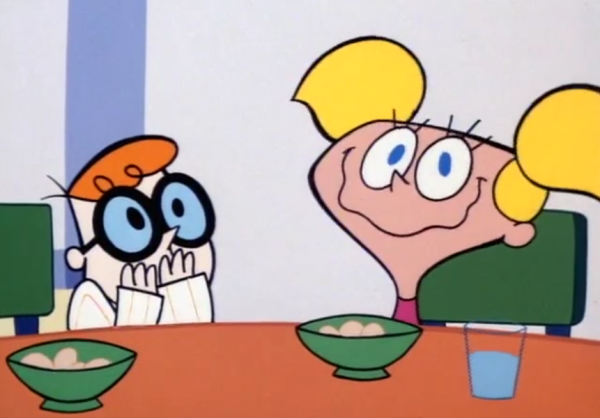
We cannot dismiss what Dexter’s Laboratory was doing when hit CN all those years ago. It’s difficult to think about it now, with so many cartoons on the air these days, but even back then the show was playing smart and coy with what kids animation was doing, and could do. It played into a lot of animation tropes, both Western and Eastern, only to undercut them with a narrative twist, a comically sudden beat, or with something so average, so anti-climatic, that you found yourself wondering if you somehow missed the actual ending. Even back then, cartoons were doing some interesting and crazy things, mostly in terms of narrative commitment, but Dexter’s Laboratory looked backwards towards classic cartoon formatting and style for inspiration. Episodes will be split between several shorts, most about Dexter and his family, but other character and show types, including “The Justice Friends” and “Dial M for Monkey.” The rhythms of the entire show will move somewhat like Rocky & Bullwinkle, an assortment of short animated bits, a format mimicked and copied all throughout the Hanna-Barbera era.
Watching the entire episode – which includes “Doll House Drama,” “Krunk’s Date,” and a brief sequence parodying comic book ads disguised as actual comics – I’m struck by the degree in which Dexter’s Laboratory really engages in that classic format. Not just in the ideas of each episode, but even in the stunted movements and somewhat off-kilter edits. The rhythms would definitely be familiar to those who grew up watching something like The Banana Splits or Yogi’s Gang. “Krunk’s Date,” in particular, utilizes a lazy, “limited laugh track” to ostensibly shore up the comedy, but is obviously used ironically here. Dexter’s Laboratory is more committed to its comic beats here than those shows would ever be, and those first two episodes ends on somewhat odd, downbeat gags that feel different than the “sad trombone” gags of its predecessors.
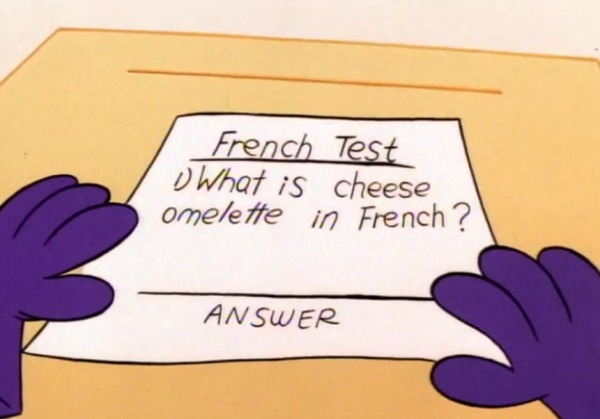
Then we get to “The Big Cheese,” an episode that hilariously steers into its one-note gag to an insane degree – only to snatch it away, hard and without warning. Rewatching this episode, I’m also struck with how patient Tartakovsky builds the gag. Dexter puts off his French homework to work on other, “more important” scientific pursuits, although some are really generic chores with complicated names. There’s no “panic” when Dexter realizes he still has to study – he just decides on a fairly normal trope – overnight osmosis. Playing a record that pipes French-lessons into his ears while he sleeps, the record skips over and over when it hits one central phrase: omelette du fromage. By the 90s, we were well in the CD/cassette era, so Dexter using a record for this feels silly, but it is central to the joke, and Dexter has been shown to disregard a lot of basic ideas for the pursuit of higher intelligence. Obviously his arrogance will prove to be his downfall, but “The Big Cheese’s” idea of a downfall is brutal.
Tartakovsky is fully aware of the trope in play, in how most shows would have its main character work around his situation to avoid being caught in one-phras-only mode. So Tarakovsky immediately has Dexter get caught. It’s by his sister, Dee-Dee, and she begins a comic repetition of her own: “That’s all you can say!” she sing-shouts, over and over, and at this point, it’s amusing. There is also a forewarning nature to it, specifically when she pops up during the montage, a sign of bad things to come. But before that point, that montage is a doozy. Montages are a dime a dozen in cartoons, but here, Tartakovsky escalates the absurdity of the situation with some impressive decision. He even starts the absurdity with a test with one single question, then ramps things up in more and more ridiculous ways. Some are a bit obvious, like omelette du fromage being a French town somehow, and the girls in the class being smitten by his use of French. The potential bullies suddenly being scared off by Dexter’s use of the phrase, however, is such a random development, precisely because unlike the previous gags, this one completely lacks any reason to have occurred.
The combination of “maybe this could happen?” and “no way this could happen” results fill up the rest of the montage. Dexter brings world peace. He becomes TIMES Man of the Year. Parades are thrown in his honor. He has a number one hit song that’s composed of, one assumes, just that phrase. It’s so dumb, but there’s a perverse comic value in seeing all the ways Tartakovsky takes this singular bit, pushing and pushing and pushing it to hilarious lengths. And it’s all pretty fantastic… up until the final moments. (I do want to point out that before Dexter enters his home, he kisses a baby, then drops it, as cameras flash. I feel like that’s a key visual sign for the next scene, but I think I’m really over-reading what amounts to a simple, hilarious joke-within-a-joke).
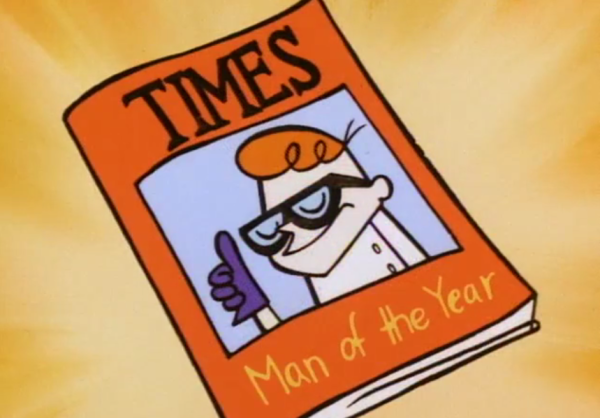
It’s in those final moments though that things turn against Dexter – the karmic, schadenfreude moment that takes thing perhaps too far. Outside his lab, the young scientist learns that his solitary word usage isn’t the password to enter his lab. His computer not only locks the lab up tighter, it begins a self-destruct sequence. Dexter, panicking and in literal tears, shouts in desperation, but only “omelette du fromage” can escape his lips. And then his sister pops up. She begins reciting in comically dark fashion the very phrase she’s been repeating all day, “That’s all you can say.” Unhelpful and useless. And if you were expecting a saving grace, a final reprieve that saves Dexter’s lab and allows the child to learn a lesson in the relative clear… it does not come. The computer says “one.” The lab completely explodes. Dexter and Dee-Dee are visible through a massive hole in their house. Fade to black. THE END pop on screen, “That’s all you can say” echoing silently in the background.
It’s pretty ridiculous in a sense. It’s a cartoon, and developing sympathy for Dexter and his lab, particularly after an episode where he skates by on a French phrase through success after success, comes across as a little weird. Dexter doesn’t really hurt anyone (except that baby, which maybe is worth discussing), and other than his hubris, there’s the question of whether the karmic destruction of his life’s work is proportional punishment to his behavior. It really isn’t his fault that he got famous off the phrase. There’s a lot to be said about the public’s infatuation over such a dumb, singular concept – and I should remind you that this episode took places years before social media and “going viral” was a thing. [I really want to do a piece about how cartoons portray crowds and public reactions; there’s a difference between mob mentality and blindly following a large group for gag purposes.] This is reminiscent of The Simpsons’ “Bart Gets Famous,” in which Bart experiences the highs and lows of success brought about by his own oft-repeated motto “I didn’t do it,” but that show had the time to draw into the reluctance and complexity of Bart’s feelings towards his entire “fifteen minutes.” With “The Big Cheese,” Tartakovsky had three minutes to get to his point, and he focused on the perfect visual display of the rise and fall of success – the fall embodied in a dark, destructive moment that shocked a young generation.
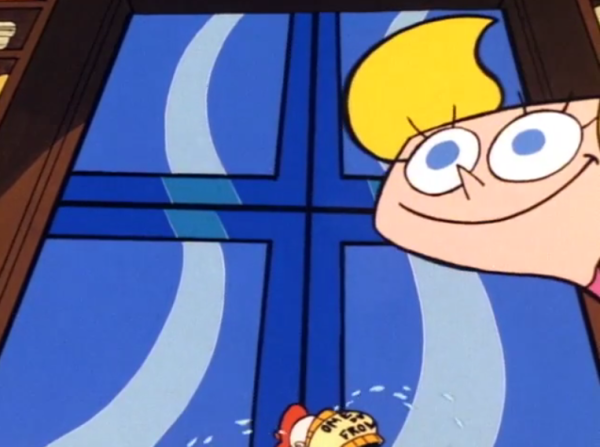
Perhaps “proportional punishment” isn’t really a thing. Sometimes you find yourself so caught up in something that you fail to realize how far you are from the things you once held dear – and they’re gone in an instant. Tartakovsky made his point clear, and it left many people with only “omelette du fromage” and “that’s all you can say” dancing in their heads, in the midst of a dark, music-less void. The very premise of the show, Dexter’s Laboratory, was gone in an instant, leaving kids to wonder if, and why, such a bleakness was warranted. As an adult, we wonder about it still.
NEXT: Rescue Rangers’ uses a badass Gadget Hackwrench to contemplate the value of religion in “The Case of the Cola Cult.”
Niko and the Sword of Light Proves Adventure Tales Still Have Merit
Posted by kjohnson1585 in Animation, Television, Uncategorized, Video Games, Writing on August 2, 2017
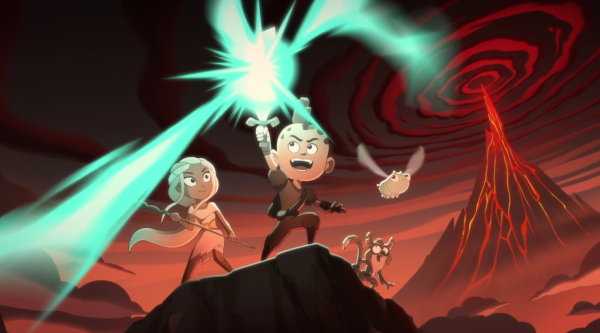
Niko and his party (which include Princess Lyra, Mandok, and Flicker) run into a stranger in the middle of the first season of Niko and the Sword of Light. The stranger is a talented, effective fighter, a rogue-type mercenary, and he proves to be a better warrior than Mandok. So of course, Niko and Lyra heap praise on this stranger while Mandok stews in jealousy. This stranger makes an important and needed contribution to the team. Every time you think he’ll betray everyone, it turns out to be a red herring. Lulls viewers into a certain set of expectations. But we’re adults, and we’ve seen these kinds of long-term adventure tales before: Lord of the Rings, The Last Airbender, hell, even The Matrix. We know that this stranger will indeed turn out to be a traitor, right as the team is at its most vulnerable. We see it coming, but even still, it’s a striking moment.
It’s a simple moment, too: it’s devoid of any massive complication or overwrought details. There’s depth to the characters, and the world they inhabit, but that depth is important insomuch as it simply provides obstacles and/or methods to overcome them. In other words, don’t expect to delve deep into lore or culture in your fan theories or thinkpieces. But what this does prove is that the basic storytelling tropes of these large, globe-trotting adventure tales can still be effective and powerful and entertaining, especially to younger kids who are new to these kinds of tales. We often forget that there’s an entire demo that hasn’t seen, watched or read these kinds of stories, so they don’t know how to look for the tell-tale signs of betrayal, or homages to Westerns or horror tropes, or the various ways high-end fantasy portrays itself. The twists are obvious but still work, and it helps that the animation is gorgeous, with big, expansive backgrounds and some of the tightest, sharpest action sequences since The Legend of Korra. All to get you into a story that we have witnessed time and time again.
The core of such a story is still engaging though, and Niko and the Sword of Light commits to it in ways that keep it fun and light AND dark and mysterious at the same time. It keeps things moving, a consistent story that manages to keep up along thirteen entire episodes, finding small twists and story beats to maintain that momentum. To be clear, those twists and beats aren’t anything new – besides the aforementioned obvious traitor, there’s the “flawed former hero,” a rally-the-troops moment, temptations galore, and many, many low points before they become inspirationally high. Discerning viewers already on the fence about watching a low-key adventure tale may also be bothered by the show’s humor, which isn’t childish per se, but it is rather basic and simplistic, and at its worst, forced into moments where the dramatic tension is thusly ruined. But there’s a reason these adventure tales are told so often: the wonder, magic, mystery, and action still can delight an audience.
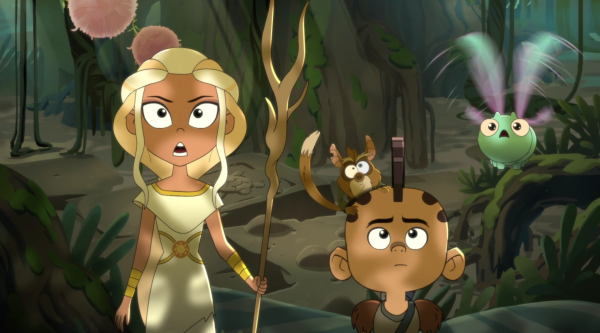
The highest point of the show is its action scenes. Dynamic, vibrant, and engaging, Titmouse has always excelled at crisp, clear, and exciting action, and they bring it to the table here. Watching Niko and Lyra do battle with huge, grotesque monsters is a treat, and it’s both amusing and impressive to watch a ten-year old boy move like a skilled gymnast warrior to dodge massive tentacles or flailing tails. And as great as the monster battles are, the show’s most rewarding fight takes place in episode nine, “From the Cliffs of Catastrophe to the Pools of Destiny” (every location is named in such a fashion, and the show more or less lampshades this convention in many scenes in which characters spout out a series of locales with similar names). Not to spoil too much, but the action here is absolutely wild, arguably the best balls-out battle since the final episode of The Last Airbender. I should also mention that, in a way that’s kind of hard to describe, the action scenes feel very much like you’re actually playing a game – like you’re pressing the buttons to actually perform the specific combos, special “light” moves, and various slick-ass dodges you see on screen. Part of that is because, yes, Niko and the Sword of Light is based on a mobile game of the same name. But it’s also because of how specific Niko’s moveset is, how he moves in action, and how he engages in actual battle. Each swing, each attack, each shouted-out-loud special move feels like an input and has an… aesthetic tactile result and response while watching. I know that saying a show feels like a video game is often negative, but here, it’s absolutely a positive.
And even if Niko and the Sword of Light is mostly a barebones adventure tales with slightly-overwrought gags and tightly storyboard action, there is just enough backend details for those who prefer to read deeper into the world. The various characters that our heroes meet lean a bit on the silly end of their characterizations, but they still feel like a culture with a long history, like the “meercoons,” who have chronicled the failures of past champions over centuries. The central story itself, in which humanity froze itself in safety while guiding said champions over such a long history to fight the darkness, grows more unique and darker over the season, with episode four’s “From the Phantom Woods to the Mountains of Misery” an excellent portrayal of exposition. (It’s even explained why Niko himself is only ten, since the crystal from which he was born was shattered too early, but he still speaks/acts like an older hero, which explains the awkward-sounding dialogue – although I can’t say that Andre Robinson’s VO work isn’t flawless.) The monsters feel like the product of arbitrary “scary” design principles until the main villain, Nar Est, admits that his monstrous creations are just his artistic flourishes. My favorite detail occurs at the Pools of Destiny (episode nine is arguably the show’s best): vague spoilers, but the Pools aren’t what they seem, a product of hyped historical precedent.
And there’s Niko and Lyra themselves. The entire crew grows closer over the course of the adventure but there’s a clear thematic understanding that occurs between the champion and the princess, an understanding that underlies the entire season. Niko’s desire to help all the various groups of people they encounter runs counter to Lyra’s overall goal of reaching and defeating Nar Est. Centuries of failure stem from overall acts of kindness for even the smaller groups of people they meet. When Niko starts to help them, he is the first of a long line of champions to offer assistance for the common person, and it leads to some small but pronounced surprises towards the end. It’s an ending that perhaps culls too much from The Last Airbender and Legend of Korra – two obvious influences, along with Samurai Jack (Nar Est is basically Akku) – but it is satisfying nonetheless, the end result of an adventure story that excels in ways both small and large. I wish the show was deeper and, perhaps, darker, but I also worry that such a direction would force it into a “gritty, serious” state, and that is not a direction that would work for such a show. Still, a bit more depth to some of the specific characters are necessary – like the three “opposterums” whose desperation to stay as a combined, cursed monster really needed exploring – and a better control over the tonal dissonance between its dramatic and comedic moments. The core storytelling is still strong however, and adventure tales like Niko and the Sword of Light still can inspire imagination and wonder in children and adults like the various tales before it.

